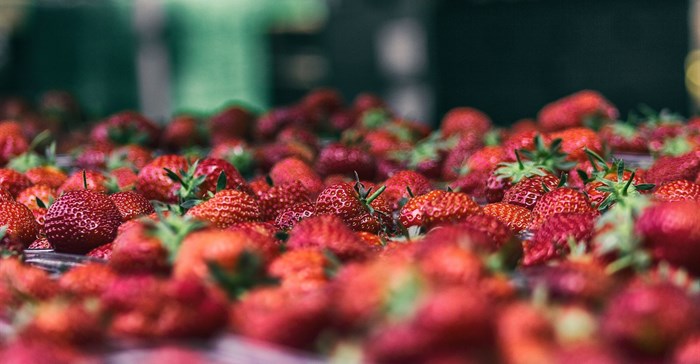The global strawberry market reached 9.2 million tonnes in 2016, 5% higher than the previous year. Th market volume underwent a robust expansion from 2007-2016 according to a report published by IndexBox,, increasing with a CAGR of +5%.
In value terms, the market reached $15.9bn in 2016 - its trend pattern remained relatively flat over the last three years. This figure reflects total revenue of producers and importers (excluding logistics costs, retail marketing costs, and retailers' margins, which will be included in the final consumer price).
The healthy food trend is becoming increasingly popular on the developed markets, such as the USA and Europe, thereby encouraging the consumption of natural products, including fruit and berries. This trend is expected to continue in the coming years. Consumers are increasingly choosing strawberries over other fruit, switching their consumer preferences from traditional fruit types.
Strong demand for strawberries is also being seen from the emerging markets in Asia, where there is ample room for market expansion, as consumption is still relatively low, but is now increasing. In the immediate term, it is forecast that strawberry consumption will continue to increase, against a rising population and the current trend for healthy food, taking the market to 11.5 million tonnes in 2025.
Increased consumption in China
The countries with the highest consumption were China (41%), the US (16%), Egypt (5%), Turkey (4%), Mexico (4%) and Germany (3%), together comprising almost 73% of global consumption.
From 2007 to 2016, the highest annual rates of growth with regard to strawberry consumption were recorded in Mexico, with a +12.7% growth, Egypt, with +12.2% growth and China, with +8.3% growth. Moreover, China significantly strengthened its share in terms of global strawberry consumption, posting tangible gains of +9 percentage points from 2007 to 2016. Egypt and Mexico also increased their shares in the global consumption over the last ten years.
Among the leading consuming countries, high levels of per capita consumption were recorded in Turkey (5.2 kg/year in 2016), Egypt (4.9 kg/year) and the US (4.5 kg/year), figures which were significantly higher than the world average of 1.2 kg/year. However, the annual growth of per capita consumption was the most notable in Mexico, where it increased at an average annual rate of +11.3% from 2007 to 2016.
Strawberry production posted solid gains over the last five years
Strawberry production reached 9.1 million tonnes in 2016, increasing by 4% over the last year. A positive dynamic also was recorded over the period under review: from 2007 to 2016, the production of strawberries increased with an annual rate of growth of +5.1%. The production of strawberries amounted to $15.6bn in value terms. Due to the fall seen in producer prices, the growth of strawberry production in value terms was less pronounced against a growth in output figures over the last years.
China was the key world strawberry producing country, with an output of 3.8 million tonnes in 2016, which accounted for 42% of the global output. The other major producers were the US (16%), Mexico and Egypt (5%, each), Turkey and Spain (4%, each).In Mexico and Egypt, production volumes increased by +11.5% annually, in China and Turkey – by +8.1% and +5.8%, respectively, from 2007 to 2016. Spain (+3.5%) and the US (+2.8%) illustrated a less pronounced growth in production over the last nine years.
Global strawberry exports
In 2016, the volume of global exports totalled 860K tonnes, with an overall upward trend over the last few years. A gradual increase over the period from 2007 to 2011 was followed by a sharp surge by 18% in 2012 with further mild fluctuations until 2016.
Spain (311K tonnes), distantly followed by the US (134K tonnes), Mexico (103K tonnes) and the Netherlands (56K tonnes), were the main global suppliers of strawberries with a combined share of 70% of global exports. They were followed by Belgium (41K tonnes), Greece (23K tonnes) and Morocco (18K tonnes). From 2007 to 2016, exports from Spain grew with an annual average growth rate of +4.6%, however, the fastest growing supplier among the major exporters was Greece (+21.4% per year). Despite being the largest global producer of strawberries, China did not export much of its production, meaning that it was consumed domestically.
US significantly increased strawberry imports
The volume of global imports totaled 918K tonnes in 2016. The imports dynamics was generally in line with exports: these trade flows globally complement each other. The share of imports in global demand accounted for about 10%.
In 2016, the US (165K tonnes), Germany (115K tonnes), Canada (103K tonnes) and France (80K tonnes) were the leading destinations of strawberries imports, together making up 51% of global imports in physical terms. They were followed by the UK (58K tonnes), Italy (35K tonnes) and Russia (29K tonnes). Amongst the major importing countries, the US (+9.8% per year) gained the highest annual growth rates from 2007 to 2016.
While the share of the US in global imports increased significantly from 10% in 2007 to 18% in 2016, the share of France (-7 percentage points) and the UK (-3 percentage points) illustrated negative dynamics. The shares of the other countries remained relatively stable throughout the analysed period.
IndexBox
























